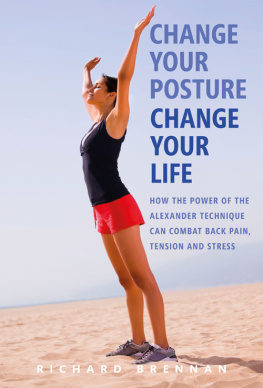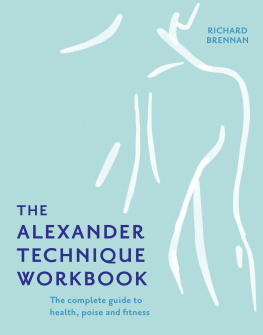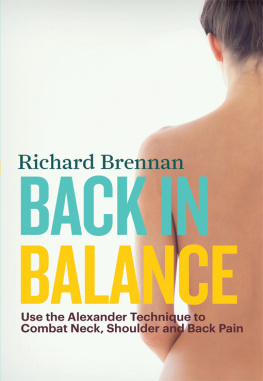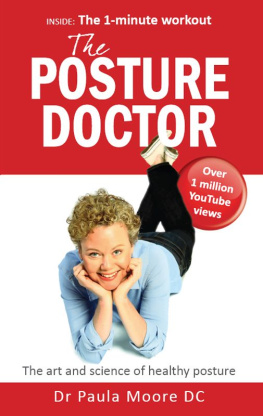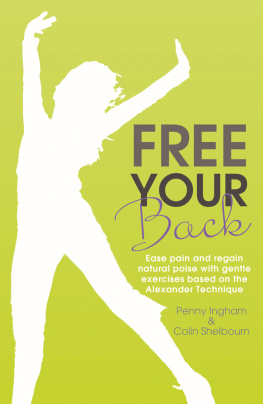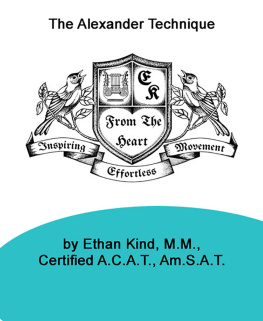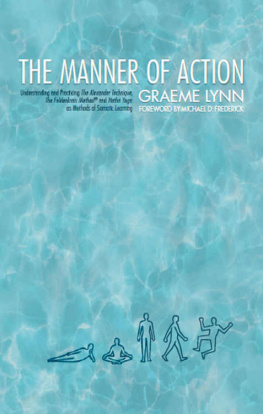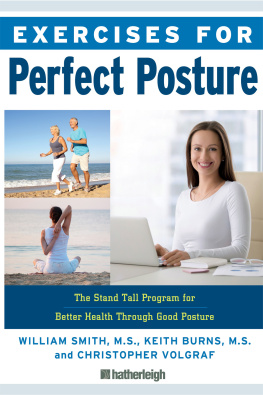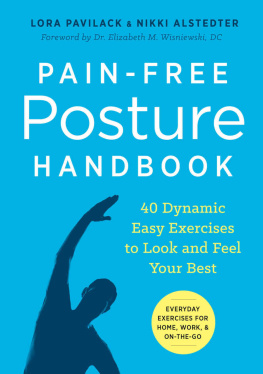Neck problems are virtually an occupational hazard for Ear, Nose and Throat surgeons. I had serious problems during my working years, but hoped for relief on early retirement. This was not the case and limitation of cervical (and thoracic) movement became quite an intrusion on my life. Physiotherapy and medication gave only short-term improvement. On being introduced to the Alexander Technique I was somewhat sceptical that anything was going to work, but can only describe the relief gained, and maintained, as quite incredible. General posture has improved and neck mobility has returned to that last experienced more than 20 years ago. What more could one ask for?
Kieran Tobin, MB, B Ch, BAO, FRCS (Eng), FRCS (Irl), DLO;
Past-President of the Irish Otolaryngological, Head and Neck Society;
Past-President of the ENT Section of the Royal Society of Medicine of Ireland
Richard Brennan is an internationally renowned author, having written four books on the Alexander Technique, which have been translated into eight languages. He travels throughout Europe and the USA giving TV and radio interviews, running workshops and giving lectures. He is the co-founder of the Irish Society of Alexander Technique Teachers (ISATT) and lives in Galway, Ireland, where he runs a busy private practice as well as being the director of the Alexander Technique Teacher Training College, Ireland, which is recognized by the Society of Teachers of the Alexander Technique Teachers (STAT). www.alexander.ie
Other books by Richard Brennan
The Alexander Technique Natural Poise for Health
The Alexander Technique Workbook
The Alexander Technique Manual
Mind and Body Stress Relief with the Alexander Technique
Stress The Alternative Solution
CHANGE YOUR POSTURE
CHANGE YOUR LIFE
HOW THE POWER OF THE ALEXANDER TECHNIQUE CAN COMBAT BACK PAIN, TENSION AND STRESS
RICHARD BRENNAN
WATKINS PUBLISHINGS
LONDON
This edition first published in the UK and USA 2012 by
Watkins Publishing, Sixth Floor, Castle House,
7576 Wells Street, London W1T 3QH
Design and typography copyright Watkins Publishing 2012
Text copyright Richard Brennan 2012
Richard Brennan has asserted his right under the Copyright, Designs
and Patents Act 1988 to be identified as the author of this work.
All rights reserved.
No part of this book may be reproduced or utilized in any form or by any means, electronic or mechanical, without prior permission in writing from the Publishers.
1 3 5 7 9 10 8 6 4 2
Designed and typeset by Jerry Goldie Graphic Design
Printed and bound by Imago in China
British Library Cataloguing-in-Publication Data Available
Library of Congress Cataloging-in-Publication Data Available
ISBN: 978-1-78028-210-7
www.watkinspublishing.co.uk
Contents
Acknowledgments
I would like to thank the following long list of people who have supported me in the writing of this book. First, I would like to give very special thanks to my wife, Caroline, for the initial proof reading and making suggestions about improvements, a great deal of computer support as well as helping with the photo-shoot. Secondly, I am very grateful to Dr Miriam Wohl, a friend, Alexander teacher and a medically trained doctor who gave generously of her time and of herself for a second (and third!) proof reading and for the many interesting discussions we had along the way. I would like to thank Kieran Tobin for writing his wonderful endorsement of the Technique at the beginning of the book and I would also like to thank the following teachers who have helped in many different ways with the production of the book: Giora Pinkas, Jessica Wolfe, Glenna Batson and Ingrid Bacci. Also I would like to say a big thank you to all those involved in the photo-shoot: the photographer, Brad Anderson, and the models, Ciaran Brennan, Laoise Brennan and Michaela Wohlgemuth, and to Julia Brown for her much needed help with the illustrations and to Paul Cook and Jeremy Chance with their help in finding the photographs of F Matthias Alexander and Jean Fisher for permission to print an extract from, The Philosophers Stone. Thanks also to my agent, Susan Mears, for initiating the project and my editor Alison Bolus for all her hard work. Lastly, but not least, I would like to thank all those people working behind the scenes at Watkins Publishing, including Michael Mann, Penny Stopa and Jerry Goldie in the production and distribution of this book.
For Cara, Tim, Ciaran and Laoise
Introduction
Are you tired of the effects of poor posture in your life? Do you feel frustrated that anything you do to try to improve your posture doesnt seem to work? Would you like a relaxed, yet upright posture, beautiful balance and graceful coordination? If so, then this book is for you!
In this book I hope to convey a simple message: your posture directly affects your bodys overall functioning and has a major influence on how you think and feel. Poor posture can also adversely affect the position and functioning of your vital organs and cause more health problems than you realize. Many people with chronic pain can trace their problems to years of faulty postural habits.
Good posture, by contrast, promotes free movement and physical and mental endurance, improves appearance and contributes to an overall feeling of wellbeing. Good posture allows the bodys healing processes to work more efficiently and effectively, and helps to prevent future illness. Good posture aligns your body and helps your muscles, joints and ligaments to do their job as nature intended. Improving posture reduces fatigue, muscular strain and pain. Good posture brings the body back into balance, physically, mentally and emotionally. A person who has good, natural posture tends to project poise, confidence, integrity and dignity.
This book is emphatically not about sitting up straight, pulling your shoulders back and arching your back, as you may often have been told to do in the past. It is about finding your natural poise again: that wonderful, graceful posture that you naturally had as a child. You will find that if you improve your posture, you will improve the quality of your life. Although the main theme of this book is to explain what the Alexander Technique is and how it can be used to improve posture, I will also explore the effects of external factors, such as chairs and shoes, on posture. I need to make it clear, however, that although these are nothing to do with the Technique as such, I have personally found that these can also be very helpful in my life and when teaching others.
Before we start exploring ways of improving posture, let me first explain how this book came about. Over the last 20 years I have run hundreds of Alexander Technique classes and workshops, and the number of people who have attended must be over 10,000 by now. One of the first things I ask the participants is: How many of you would like to improve your posture? Every time, without fail, nearly everyone puts their hand up without a moments hesitation. The reasons given for wanting to improve posture vary greatly. Some people suffer from various muscular complaints, such as hip, back or neck problems, while others have asthma, stress or various types of Repetitive Strain Injury (RSI). Quite a few may have no physical pain at all, but just want to look better and improve their general coordination and ease of movement. Some simply want to improve their self-esteem. Whatever the reason, however, it seems that many, many people are aware that bad posture is a large part of their problem.
Next page
